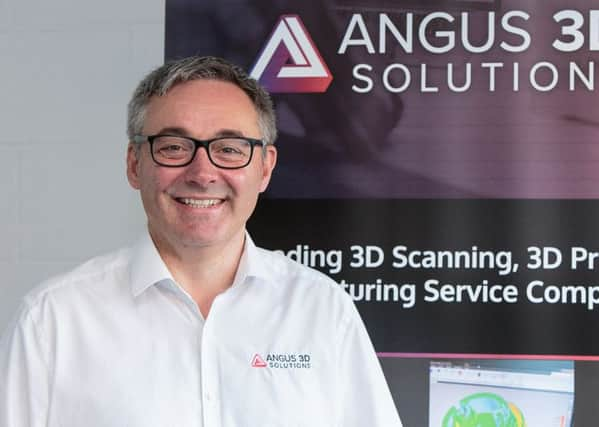Andy Simpson: Scottish firms need to adopt 3D vision


Additive manufacturing, or 3D printing as it’s fondly known, is a process of making three-dimensional solid objects from a digital file. The creation of a 3D-printed object is achieved using additive processes, where an object is created by laying down successive layers of material.
Companies wrongly presume they have to be involved in one of the ‘sexy’ manufacturing industries like aerospace, F1, automotive or medical to benefit or use this technology, which is far from reality. Additive manufacturing was used significantly in the creation of concept and prototype models for new designs and products.
Advertisement
Hide AdAdvertisement
Hide AdDue to minimum materials choices and the high costs associated with the technology, these were seen as prohibitive to the majority of manufacturing companies and therefore the technology was deemed only suitable for the ‘sexy’ industries.
Scottish manufacturing can now learn from these industries and benefit from how they’ve used and developed the processes and materials used.
The technology is no longer limited to the manufacturing of concept-of-prototype models in plastics. It’s used to manufacture finished products in high-grade plastics, composites and metals.
The processes and materials are such a high grade that the final manufactured parts are commonly found and used in planes, cars, rockets and to replace bone in surgery.
The majority of Scotland’s manufacturers aren’t involved in these ‘sexy’ industries, but they are in some of the most innovative and world-impacting technologies. So, why do they think this technology isn’t for them? We need to challenge this outdated opinion and show how this technology can help most manufacturing industries in Scotland.
Three areas where additive manufacturing can benefit Scottish manufacturing are new design, manufacturing support and extending product life.
Producing concept and prototype parts to check design will always help to verify and aid communication before manufacture. This reduces design time, costs and, more importantly, allows changes to be identified quickly to help produce products that meet the operational requirement.
For the manufacture of final components which are customised, complex, lightweight and have the ability to consolidate parts – all using less materials and promoting design freedom – this technology enables us to focus on the function, increase frequency of design changes, refine the design, question manufacturing tradition and make products feature-rich.
Advertisement
Hide AdAdvertisement
Hide AdOne of the largest opportunities is in the manufacture of special tooling and jig and fixtures to aid production, inspection and assembly. Jigs and fixtures don’t have the glamour of final parts, but they are necessary in the majority of manufacturing businesses.
These are normally produced using subtractive manufacturing in traditional materials. 3D printing can use composite materials that are hard-wearing, lighter, quick to produce and, in most cases, at a lower cost.
This method also helps to release capacity on traditional machine tools, which increases the direct production hours from these assets. This is using 3D printing to aid, rather than replace, traditional machining processes and methods, improving efficiency and utilisation of traditional machine tools.
Additive manufacturing will also help Scotland develop a ‘circular economy’, which, in simple terms, means we make, use and remake as opposed to make, use and dispose. The ultimate goal is to keep products circulating in a high-value state of use for as long as possible and maximise resources.
One way this can be achieved is in the replacing or repairing of assets to extend their useful life. 3D printing can play a significant part in a circular economy as obsolete parts can be re-engineered and manufactured directly, or to produce patterns for investment casting or vacuum injection-moulding methods to produce the replacement components.
Scotland has an impressive engineering and manufacturing history. I believe to maintain and further develop this reputation we must embrace the latest technology and encourage the next generation to look at engineering and manufacturing as a career choice.
CeeD understands that manufacturing and the supply chain is increasingly changing and has been a great support in bringing companies together to explore how technologies like additive manufacturing can benefit them and allow Scotland’s manufacturing companies to remain competitive in a global market.
Andy Simpson, managing director, Angus 3D Solutions Ltd.